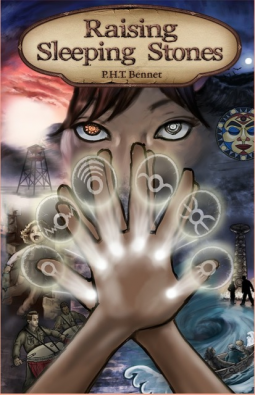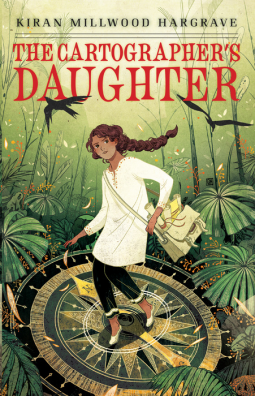Born Confused by Tanuja Desai Hidier.
Dimple Lala is an American Indian (as in East Indian, not Native American) caught between the traditional world of her parents and the life of a normal American teenager. Her best friend, willowy blonde ultra-cool Gwyn, thinks Indian culture is exotic and cool. Dimple’s one passion is her photography, and the world as she sees it through her camera lens is described in luminescent detail. Only here can she be herself, instead of awkward and alienated. At school, she can never compete with Gwyn; at home, wishes her meddling parents would stay out of her hair. When they arrange an introduction to a “suitable boy” (suitable for an arranged marriage, that is), Dimple goes on a blind date that Gwyn had set up, with predictably disastrous consequences. As the story unfolds, spilling out into the Indian music club scene, Dimple comes into her own, fusing the best of both worlds. An array of vivid secondary character and gorgeous sensory detail mark this as a book to be savored and shared.
We Are the Goldens by Dana Reinhardt.
This book is deceptively simple in tone yet rich in nuance and courageous in its approach to complex, painful issues. This book chronicles the parallel journeys of two teenaged sisters, using an interesting twist on the usual YA first-person narrative in that one sister is addressing the other: their relationship forms the core of the story as they grow from intertwined to antagonistic to individuated. The story opens with the narrator and younger sister, Nell, beginning high school and discovering that the previously close relationship with adored, perfect Layla has now developed fracture lines. While Nell develops an unrequited crush on a glamorous older boy, Layla begins acting mysteriously. She, too, has a secret – one that Nell discovers and that has the power to tear them and their whole family apart. Highly recommended for both adult and teen readers for its clear and excellent handling of relationships and sexuality.
The Cartographer's Daughter, by Kiran Millwood Hargrave.
This lovely middle grade story offers a wonderful twist to the usual fantasy tale featuring adolescent heroes. The protagonist’s strength is not magic or physical prowess but her understanding of how our knowledge of the landscape gives us power. The techniques of map-making are woven into the story in beautiful, evocative ways. The plot itself involves a group of friends, a journey to forbidden lands, monsters and creatures, villains and allies. Much has a familiar feel, but the use of cartography makes this book stand out. It would make a great book for a family to read together and discuss the principles of geography and their relationship to the plot.
Dystopic settings continue to be popular for teen and younger readers. I’m not usually a fan of grim, hopeless worlds, but these two books gave me a modicum of insight into why they appeal. In a society in which the normal pattern of childhood and adolescent/apprenticeship years has become distorted for whatever reason, young characters acquire agency (autonomy, responsibility, freedom to make choices and changes) they might not otherwise have.
 Raising Sleeping Stones (The Orora Crona Chronicles, Book 1) by P.H.T. Bennet begins with nicely-executed world-building and an appealing central character (and her annoying younger sister). With deft strokes that never overwhelm the action, Bennet creates a world dominated by Guilds, in which every effort is directed toward building the city further and further westward. Every “Move Up Day,” families pack up and move into new housing, their address determined by their contributions to the work. Children focus on narrowly work-related skills, aiming at admission to prestigious Guilds. Creativity and accuracy are sacrificed for speed. The culture hurtles to an unsustainable future as ever more pressure comes to bear on its fragile and fracturing human inhabitants. Of course, secrets lie buried in the direction of the abandoned husks, as our two children discover.
Raising Sleeping Stones (The Orora Crona Chronicles, Book 1) by P.H.T. Bennet begins with nicely-executed world-building and an appealing central character (and her annoying younger sister). With deft strokes that never overwhelm the action, Bennet creates a world dominated by Guilds, in which every effort is directed toward building the city further and further westward. Every “Move Up Day,” families pack up and move into new housing, their address determined by their contributions to the work. Children focus on narrowly work-related skills, aiming at admission to prestigious Guilds. Creativity and accuracy are sacrificed for speed. The culture hurtles to an unsustainable future as ever more pressure comes to bear on its fragile and fracturing human inhabitants. Of course, secrets lie buried in the direction of the abandoned husks, as our two children discover.
The skill of the world building and the dramatic twists kept me reading for quite some time. Another strength were the charming illustrations and sheer imagination. In the end, though, I found the story bogged down in long descriptions, characters telling one another what they already knew, adults talking like teens, and other aspects that might not be experienced as flaws for the intended audience. I suspect that younger readers will eat it up, however, and this book and its sequels will be excellent for reading and discussing together as a family.
Dimple Lala is an American Indian (as in East Indian, not Native American) caught between the traditional world of her parents and the life of a normal American teenager. Her best friend, willowy blonde ultra-cool Gwyn, thinks Indian culture is exotic and cool. Dimple’s one passion is her photography, and the world as she sees it through her camera lens is described in luminescent detail. Only here can she be herself, instead of awkward and alienated. At school, she can never compete with Gwyn; at home, wishes her meddling parents would stay out of her hair. When they arrange an introduction to a “suitable boy” (suitable for an arranged marriage, that is), Dimple goes on a blind date that Gwyn had set up, with predictably disastrous consequences. As the story unfolds, spilling out into the Indian music club scene, Dimple comes into her own, fusing the best of both worlds. An array of vivid secondary character and gorgeous sensory detail mark this as a book to be savored and shared.
We Are the Goldens by Dana Reinhardt.
This book is deceptively simple in tone yet rich in nuance and courageous in its approach to complex, painful issues. This book chronicles the parallel journeys of two teenaged sisters, using an interesting twist on the usual YA first-person narrative in that one sister is addressing the other: their relationship forms the core of the story as they grow from intertwined to antagonistic to individuated. The story opens with the narrator and younger sister, Nell, beginning high school and discovering that the previously close relationship with adored, perfect Layla has now developed fracture lines. While Nell develops an unrequited crush on a glamorous older boy, Layla begins acting mysteriously. She, too, has a secret – one that Nell discovers and that has the power to tear them and their whole family apart. Highly recommended for both adult and teen readers for its clear and excellent handling of relationships and sexuality.
The Cartographer's Daughter, by Kiran Millwood Hargrave.
This lovely middle grade story offers a wonderful twist to the usual fantasy tale featuring adolescent heroes. The protagonist’s strength is not magic or physical prowess but her understanding of how our knowledge of the landscape gives us power. The techniques of map-making are woven into the story in beautiful, evocative ways. The plot itself involves a group of friends, a journey to forbidden lands, monsters and creatures, villains and allies. Much has a familiar feel, but the use of cartography makes this book stand out. It would make a great book for a family to read together and discuss the principles of geography and their relationship to the plot.
Dystopic settings continue to be popular for teen and younger readers. I’m not usually a fan of grim, hopeless worlds, but these two books gave me a modicum of insight into why they appeal. In a society in which the normal pattern of childhood and adolescent/apprenticeship years has become distorted for whatever reason, young characters acquire agency (autonomy, responsibility, freedom to make choices and changes) they might not otherwise have.
 Raising Sleeping Stones (The Orora Crona Chronicles, Book 1) by P.H.T. Bennet begins with nicely-executed world-building and an appealing central character (and her annoying younger sister). With deft strokes that never overwhelm the action, Bennet creates a world dominated by Guilds, in which every effort is directed toward building the city further and further westward. Every “Move Up Day,” families pack up and move into new housing, their address determined by their contributions to the work. Children focus on narrowly work-related skills, aiming at admission to prestigious Guilds. Creativity and accuracy are sacrificed for speed. The culture hurtles to an unsustainable future as ever more pressure comes to bear on its fragile and fracturing human inhabitants. Of course, secrets lie buried in the direction of the abandoned husks, as our two children discover.
Raising Sleeping Stones (The Orora Crona Chronicles, Book 1) by P.H.T. Bennet begins with nicely-executed world-building and an appealing central character (and her annoying younger sister). With deft strokes that never overwhelm the action, Bennet creates a world dominated by Guilds, in which every effort is directed toward building the city further and further westward. Every “Move Up Day,” families pack up and move into new housing, their address determined by their contributions to the work. Children focus on narrowly work-related skills, aiming at admission to prestigious Guilds. Creativity and accuracy are sacrificed for speed. The culture hurtles to an unsustainable future as ever more pressure comes to bear on its fragile and fracturing human inhabitants. Of course, secrets lie buried in the direction of the abandoned husks, as our two children discover.The skill of the world building and the dramatic twists kept me reading for quite some time. Another strength were the charming illustrations and sheer imagination. In the end, though, I found the story bogged down in long descriptions, characters telling one another what they already knew, adults talking like teens, and other aspects that might not be experienced as flaws for the intended audience. I suspect that younger readers will eat it up, however, and this book and its sequels will be excellent for reading and discussing together as a family.



No comments:
Post a Comment